engine Hyundai Coupe 2005 Owners Manual
[x] Cancel search | Manufacturer: HYUNDAI, Model Year: 2005, Model line: Coupe, Model: Hyundai Coupe 2005Pages: 478, PDF Size: 13.44 MB
Page 254 of 478
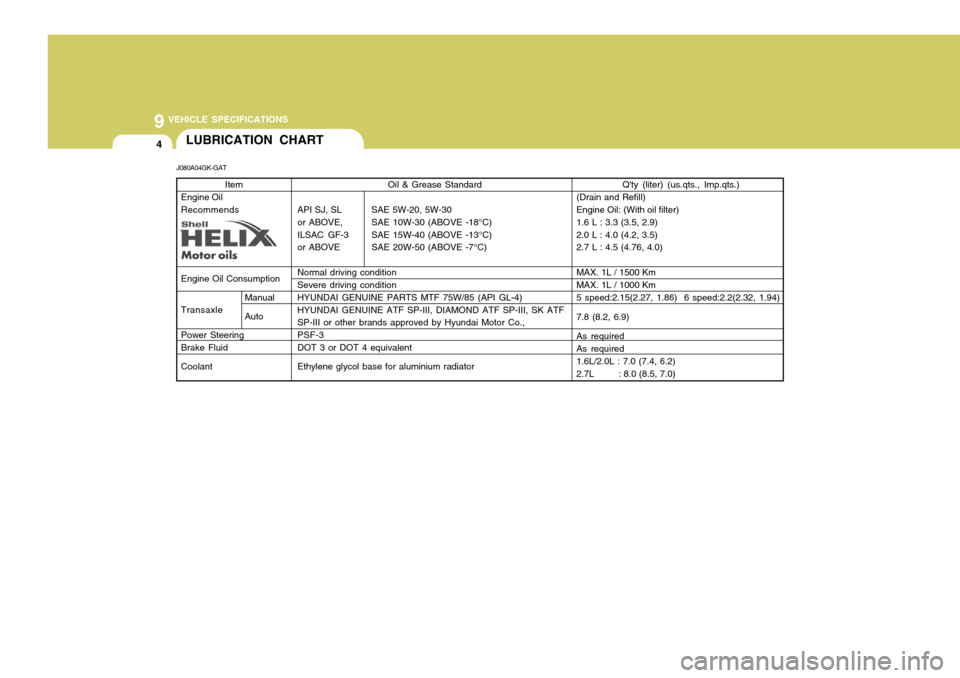
9 VEHICLE SPECIFICATIONS
4
Q'ty (liter) (us.qts., Imp.qts.)
(Drain and Refill) Engine Oil: (With oil filter) 1.6 L : 3.3 (3.5, 2.9)2.0 L : 4.0 (4.2, 3.5) 2.7 L : 4.5 (4.76, 4.0) MAX. 1L / 1500 Km MAX. 1L / 1000 Km 5 speed:2.15(2.27, 1.86) 6 speed:2.2(2.32, 1.94) 7.8 (8.2, 6.9) As required As required1.6L/2.0L : 7.0 (7.4, 6.2) 2.7L : 8.0 (8.5, 7.0)
LUBRICATION CHART
J080A04GK-GAT Oil & Grease Standard
API SJ, SL SAE 5W-20, 5W-30
or ABOVE, SAE 10W-30 (ABOVE -18°C)
ILSAC GF-3 SAE 15W-40 (ABOVE -13°C)
or ABOVE SAE 20W-50 (ABOVE -7°C) Normal driving condition Severe driving condition HYUNDAI GENUINE PARTS MTF 75W/85 (API GL-4)HYUNDAI GENUINE ATF SP-III, DIAMOND ATF SP-III, SK ATF SP-III or other brands approved by Hyundai Motor Co., PSF-3DOT 3 or DOT 4 equivalent Ethylene glycol base for aluminium radiator
Item
Engine Oil Recommends Engine Oil Consumption Transaxle Power Steering Brake Fluid Coolant
Manual Auto
Page 257 of 478
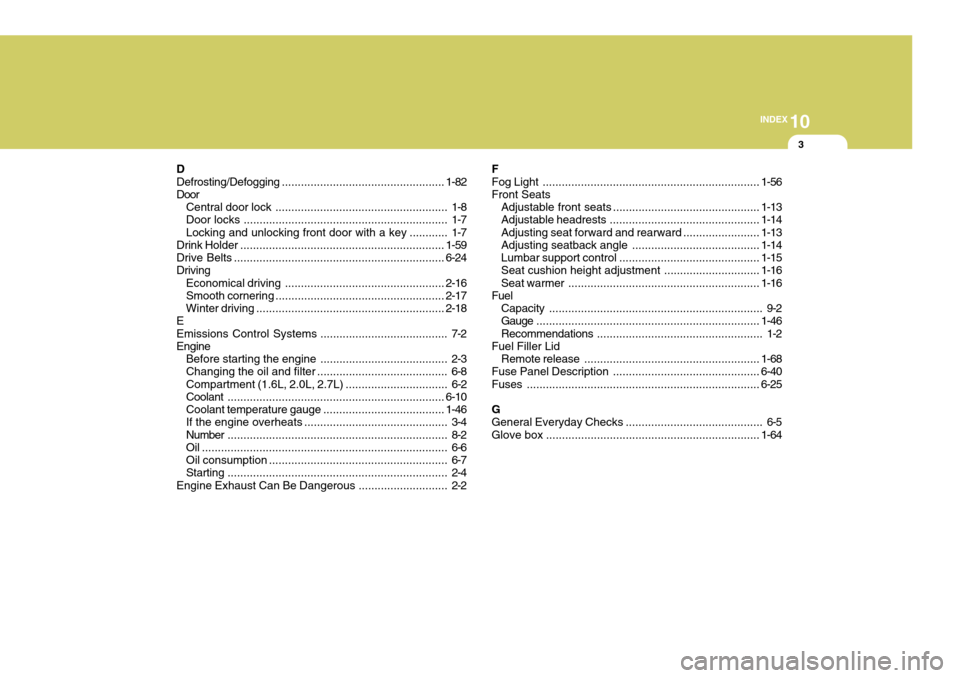
10
INDEX
3
D Defrosting/Defogging ................................................... 1-82
Door
Central door lock ...................................................... 1-8
Door locks ................................................................ 1-7Locking and unlocking front door with a key ............ 1-7
Drink Holder ................................................................ 1-59
Drive Belts .................................................................. 6-24
Driving
Economical driving .................................................. 2-16
Smooth corneri ng ..................................................... 2-17
Winter driving ........................................................... 2-18
E
Emissions Control Systems ........................................ 7-2 Engine
Before starting the engine ........................................ 2-3
Changing the oil and filter ......................................... 6-8 Compartment (1.6L, 2.0L, 2.7L) ................................ 6-2
Coolant .................................................................... 6-10
Coolant temperature gauge ......................................1-46
If the engine overheats ............................................. 3-4
Number ..................................................................... 8-2
Oil ............................................................................. 6-6Oil consumption ........................................................ 6-7
Starting ..................................................................... 2-4
Engine Exhaust Can Be Dangerous ............................ 2-2 FFog Light
.................................................................... 1-56
Front Seats
Adjustable front seats .............................................. 1-13
Adjustable headrests ............................................... 1-14
Adjusting seat forward and rearward ........................1-13
Adjusting seatback angle .. ......................................1-14
Lumbar support control ............................................ 1-15
Seat cushion height adjustment .............................. 1-16
Seat warmer ............................................................ 1-16
Fuel
Capacity ................................................................... 9-2
Gauge ...................................................................... 1-46
Recommendations .................................................... 1-2
Fuel Filler Lid
Remote release ....................................................... 1-68
Fuse Panel Description .............................................. 6-40
Fuses ......................................................................... 6-25
G
General Everyday Checks ..... ...................................... 6-5
Glove box ................................................................... 1-64
Page 264 of 478
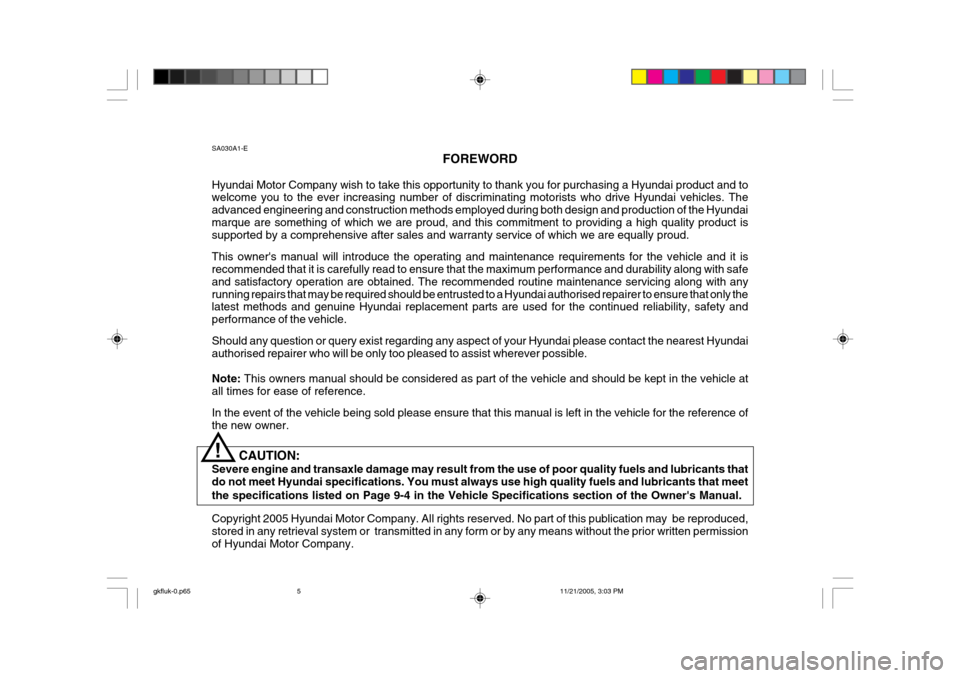
SA030A1-EFOREWORD
Hyundai Motor Company wish to take this opportunity to thank you for purchasing a Hyundai product and to welcome you to the ever increasing number of discriminating motorists who drive Hyundai vehicles. The advanced engineering and construction methods employed during both design and production of the Hyundaimarque are something of which we are proud, and this commitment to providing a high quality product is supported by a comprehensive after sales and warranty service of which we are equally proud. This owner's manual will introduce the operating and maintenance requirements for the vehicle and it is recommended that it is carefully read to ensure that the maximum performance and durability along with safe and satisfactory operation are obtained. The recommended routine maintenance servicing along with anyrunning repairs that may be required should be entrusted to a Hyundai authorised repairer to ensure that only the latest methods and genuine Hyundai replacement parts are used for the continued reliability, safety and performance of the vehicle. Should any question or query exist regarding any aspect of your Hyundai please contact the nearest Hyundai authorised repairer who will be only too pleased to assist wherever possible. Note: This owners manual should be considered as part of the vehicle and should be kept in the vehicle at
all times for ease of reference. In the event of the vehicle being sold please ensure that this manual is left in the vehicle for the reference of the new owner.
CAUTION:
Severe engine and transaxle damage may result from the use of poor quality fuels and lubricants that do not meet Hyundai specifications. You must always use high quality fuels and lubricants that meet the specifications listed on Page 9-4 in the Vehicle Specifications section of the Owner's Manual. Copyright 2005 Hyundai Motor Company. All rights reserved. No part of this publication may be reproduced, stored in any retrieval system or transmitted in any form or by any means without the prior written permissionof Hyundai Motor Company.
!
gkfluk-0.p65 11/21/2005, 3:03 PM
5
Page 267 of 478

A100A01L-EAT GUIDE TO HYUNDAI GENUINE PARTS
1. What are Hyundai GenuineParts?
Hyundai Genuine Parts are the same parts used by Hyundai Motor Com- pany to manufacture vehicles. Theyare designed and tested for the opti- mum safety, performance, and reli- ability to our customers.
2. Why should you use genuine parts?
Hyundai Genuine Parts are engineered and built to meet rigid manufacturing requirements. Using imitation, counter- feit or used salvage parts is not covered under the Hyundai New Vehicle LimitedWarranty or any other Hyundai war- ranty. In addition, any damage to or failure of Genuine Hyundai Parts causedby the installation or failure of an imita- tion, counterfeit or used salvage part is not covered by Hyundai Motor Com-pany.
3. How can you tell if you are
purchasing Hyundai Genuine Parts?
Look for the Hyundai Genuine Parts Logo on the package (see below). The export specifications are written inEnglish only. Hyundai Genuine Parts are only soldthrough Hyundai authorised repairers.
A100A01L
A100A02L A100A04L
A100A03L
gkfluk-0.p65
11/21/2005, 3:03 PM
8
Page 273 of 478
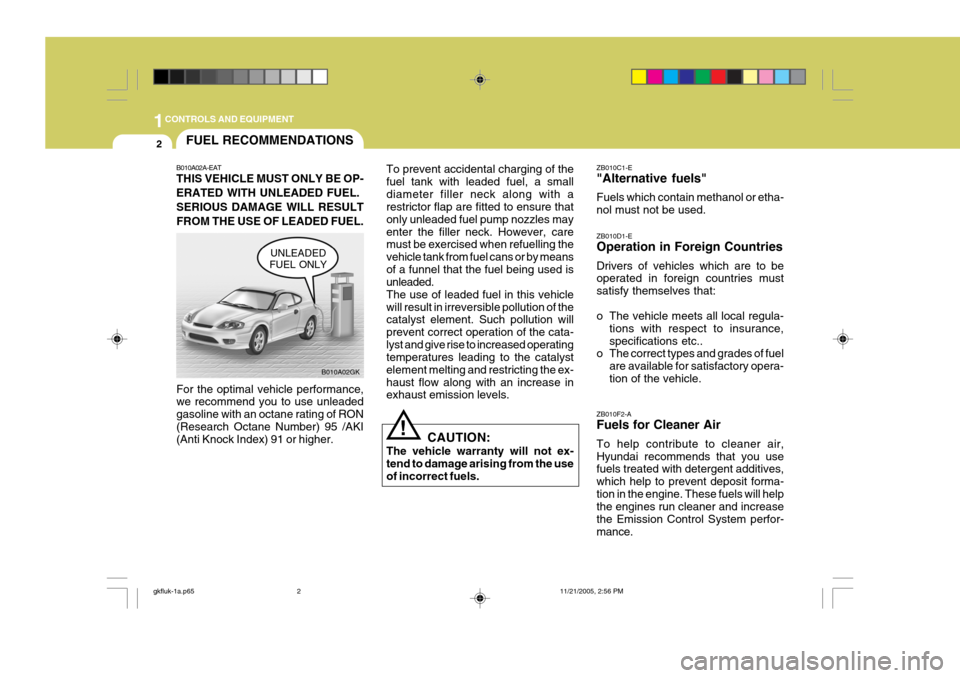
1CONTROLS AND EQUIPMENT
2FUEL RECOMMENDATIONS
B010A02A-EAT THIS VEHICLE MUST ONLY BE OP- ERATED WITH UNLEADED FUEL.SERIOUS DAMAGE WILL RESULTFROM THE USE OF LEADED FUEL. For the optimal vehicle performance, we recommend you to use unleaded gasoline with an octane rating of RON(Research Octane Number) 95 /AKI (Anti Knock Index) 91 or higher. To prevent accidental charging of the fuel tank with leaded fuel, a smalldiameter filler neck along with a restrictor flap are fitted to ensure that only unleaded fuel pump nozzles mayenter the filler neck. However, care must be exercised when refuelling the vehicle tank from fuel cans or by meansof a funnel that the fuel being used is unleaded. The use of leaded fuel in this vehiclewill result in irreversible pollution of the catalyst element. Such pollution will prevent correct operation of the cata-lyst and give rise to increased operating temperatures leading to the catalyst element melting and restricting the ex-haust flow along with an increase in exhaust emission levels.
!
B010A02GK
UNLEADED
FUEL ONLY ZB010C1-E "Alternative fuels" Fuels which contain methanol or etha- nol must not be used. ZB010F2-A Fuels for Cleaner Air To help contribute to cleaner air, Hyundai recommends that you use fuels treated with detergent additives, which help to prevent deposit forma-tion in the engine. These fuels will help the engines run cleaner and increase the Emission Control System perfor-mance.
ZB010D1-E Operation in Foreign Countries Drivers of vehicles which are to be operated in foreign countries must satisfy themselves that:
o The vehicle meets all local regula-
tions with respect to insurance, specifications etc..
o The correct types and grades of fuel
are available for satisfactory opera-tion of the vehicle.
CAUTION:
The vehicle warranty will not ex- tend to damage arising from the use of incorrect fuels.
gkfluk-1a.p65 11/21/2005, 2:56 PM
2
Page 274 of 478
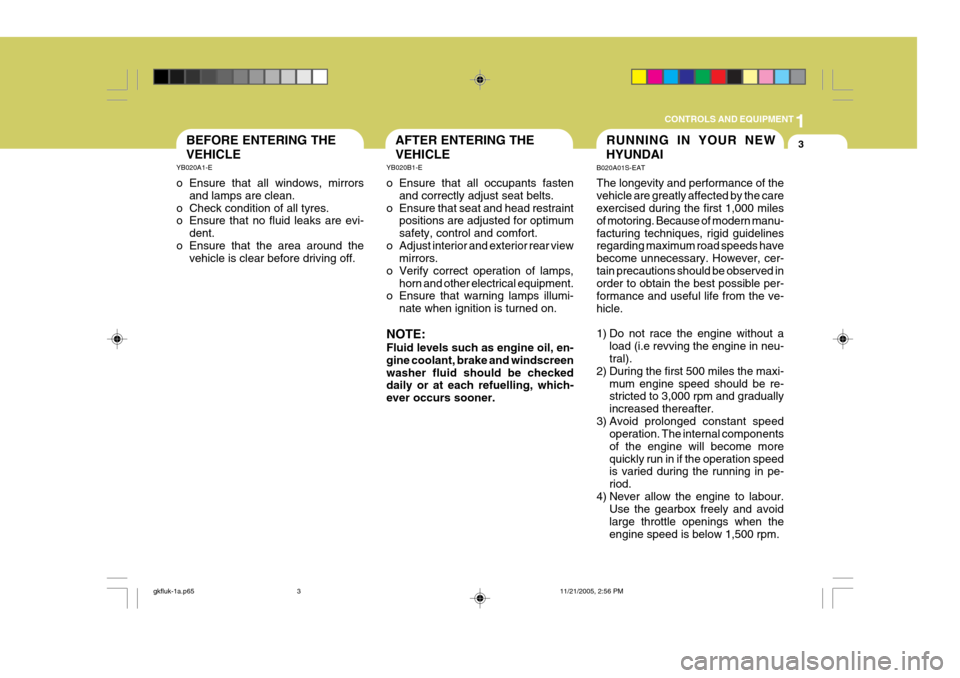
1
CONTROLS AND EQUIPMENT
3RUNNING IN YOUR NEW HYUNDAI
B020A01S-EAT The longevity and performance of the vehicle are greatly affected by the care exercised during the first 1,000 miles of motoring. Because of modern manu-facturing techniques, rigid guidelines regarding maximum road speeds have become unnecessary. However, cer-tain precautions should be observed in order to obtain the best possible per- formance and useful life from the ve-hicle.
1) Do not race the engine without a
load (i.e revving the engine in neu- tral).
2) During the first 500 miles the maxi- mum engine speed should be re-stricted to 3,000 rpm and gradually increased thereafter.
3) Avoid prolonged constant speed operation. The internal componentsof the engine will become morequickly run in if the operation speed is varied during the running in pe- riod.
4) Never allow the engine to labour. Use the gearbox freely and avoidlarge throttle openings when theengine speed is below 1,500 rpm.BEFORE ENTERING THE VEHICLEAFTER ENTERING THE VEHICLE
YB020A1-E
o Ensure that all windows, mirrors
and lamps are clean.
o Check condition of all tyres.
o Ensure that no fluid leaks are evi-
dent.
o Ensure that the area around the vehicle is clear before driving off. YB020B1-E
o Ensure that all occupants fasten
and correctly adjust seat belts.
o Ensure that seat and head restraint positions are adjusted for optimum safety, control and comfort.
o Adjust interior and exterior rear view mirrors.
o Verify correct operation of lamps, horn and other electrical equipment.
o Ensure that warning lamps illumi-
nate when ignition is turned on.
NOTE: Fluid levels such as engine oil, en- gine coolant, brake and windscreenwasher fluid should be checked daily or at each refuelling, which- ever occurs sooner.
gkfluk-1a.p65 11/21/2005, 2:56 PM
3
Page 275 of 478
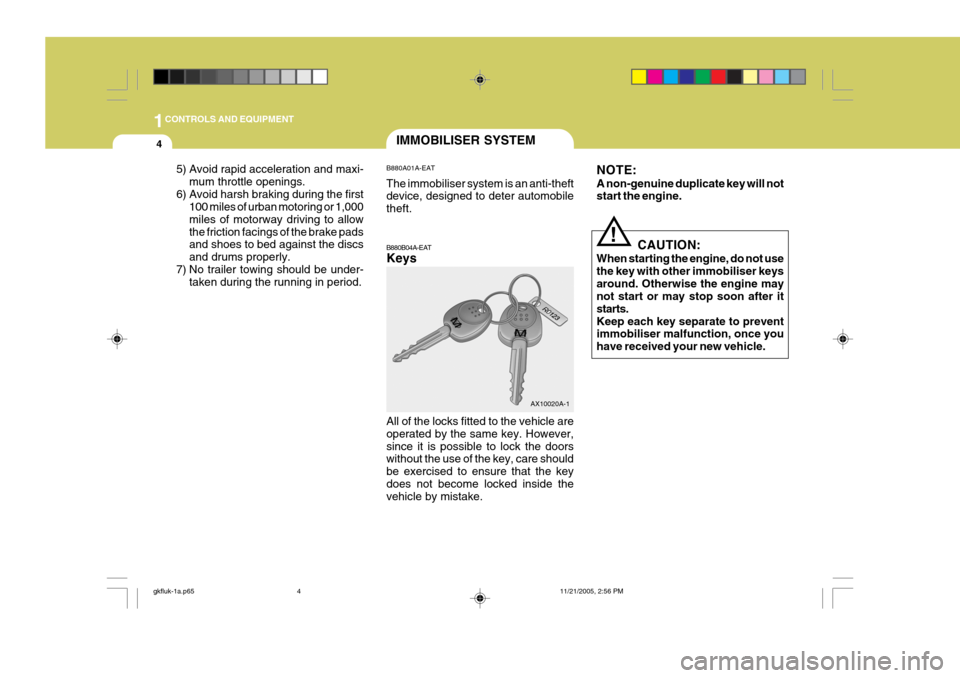
1CONTROLS AND EQUIPMENT
4
!
IMMOBILISER SYSTEM
B880B04A-EAT Keys All of the locks fitted to the vehicle are operated by the same key. However,since it is possible to lock the doors without the use of the key, care should be exercised to ensure that the keydoes not become locked inside the vehicle by mistake. AX10020A-1
5) Avoid rapid acceleration and maxi-
mum throttle openings.
6) Avoid harsh braking during the first 100 miles of urban motoring or 1,000 miles of motorway driving to allowthe friction facings of the brake pads and shoes to bed against the discs and drums properly.
7) No trailer towing should be under- taken during the running in period. B880A01A-EAT The immobiliser system is an anti-theft device, designed to deter automobile theft.
NOTE: A non-genuine duplicate key will not start the engine.
CAUTION:
When starting the engine, do not use the key with other immobiliser keysaround. Otherwise the engine may not start or may stop soon after it starts.Keep each key separate to prevent immobiliser malfunction, once you have received your new vehicle.
gkfluk-1a.p65 11/21/2005, 2:56 PM
4
Page 279 of 478

1CONTROLS AND EQUIPMENT
8
!
B070D04GK-EAT Disarmed Stage
UNLOCK
The system will be disarmed when either of the following steps are taken: CAUTION:
Avoid trying to start the engine whilethe system is armed.
B070D01GK
LOCK!
B070C01GK-EAT Alarm Stage The alarm will be activated if any of the following occur while the car is parked and the system is armed.
1) A front door is unlocked and opened without using the transmitter.
2) The hatchback door is opened with- out using the key.
3) The engine bonnet is opened.The siren will sound and the turn signal lamp will blink continuously for approxi- mately 30 seconds. To turn off thesystem, unlock the door with the trans- mitter.
B070B02GK-EAT Armed Stage Park the car and stop the engine. Arm the system as described below.
1) Remove the ignition key from the
ignition switch.
2) Make sure that the engine bonnet, doors and hatchback door are closed.
3) Lock the doors using the transmitter of the keyless entry system.
After completion of the steps above, the turn signal lamp will blink once to indicate that the system is armed. NOTE:
1) If any door, hatchback door or engine bonnet remains open, the system will not be armed.
2) If this happens, rearm the system as described above.
3) Once the system is armed, only
the hatchback door may be un- locked using the key without dis- arming the system. CAUTION:
Do not arm the system until allpassengers have left the car. If thesystem is armed while a passenger(s) remains in the car, the alarm may be activated whenthe remaining passenger(s) leaves the car.
gkfluk-1a.p65 11/21/2005, 2:56 PM
8
Page 304 of 478
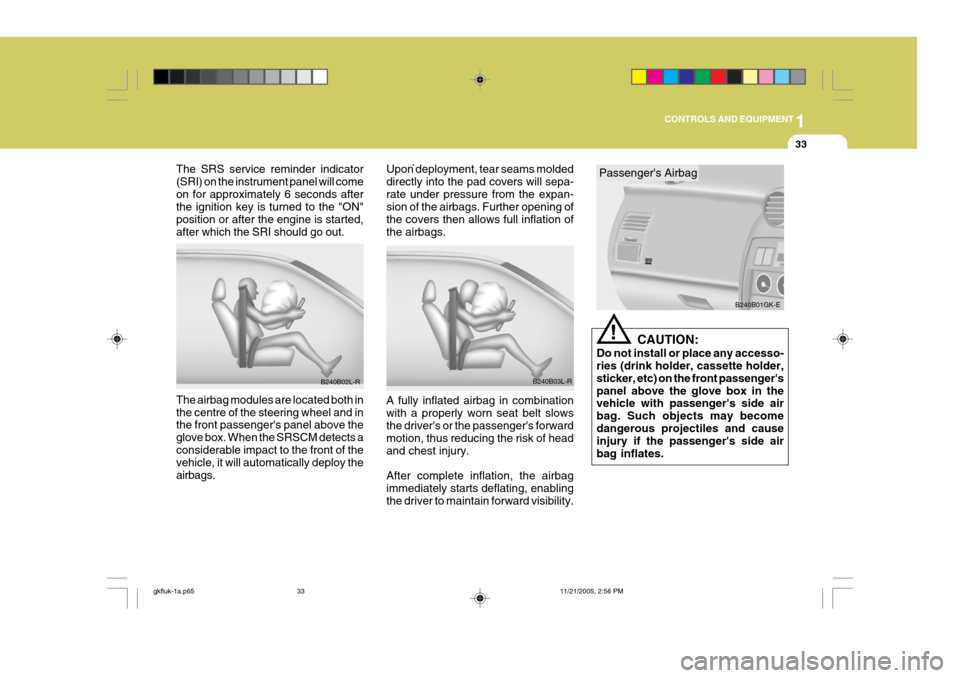
1
CONTROLS AND EQUIPMENT
33
The SRS service reminder indicator (SRI) on the instrument panel will comeon for approximately 6 seconds after the ignition key is turned to the "ON" position or after the engine is started,after which the SRI should go out. The airbag modules are located both in the centre of the steering wheel and in the front passenger's panel above the glove box. When the SRSCM detects aconsiderable impact to the front of the vehicle, it will automatically deploy the airbags. B240B02L-R Passenger's Airbag
Upon deployment, tear seams moldeddirectly into the pad covers will sepa-rate under pressure from the expan- sion of the airbags. Further opening of the covers then allows full inflation ofthe airbags. A fully inflated airbag in combination with a properly worn seat belt slows the driver's or the passenger's forward motion, thus reducing the risk of headand chest injury. After complete inflation, the airbag immediately starts deflating, enabling the driver to maintain forward visibility. B240B03L-R
B240B01GK-E
!
CAUTION:
Do not install or place any accesso- ries (drink holder, cassette holder, sticker, etc) on the front passenger'spanel above the glove box in the vehicle with passenger's side air bag. Such objects may becomedangerous projectiles and cause injury if the passenger's side air bag inflates.
gkfluk-1a.p65 11/21/2005, 2:56 PM
33
Page 305 of 478

1CONTROLS AND EQUIPMENT
34
!WARNING:
o When the SRS is activated, there may be a loud noise and fine dust will be released throughout the vehicle. These conditions are normal and are not hazardous.However, the fine dust generated during airbag deployment may cause skin irritation. Wash yourhands and face thoroughly with lukewarm water and a mild soap after an accident in which theairbags were deployed.
o The SRS can function only when
the ignition key is in the "ON"position. If the SRS SRI does not flash, or continuously remains on after flashing for approxi-mately 6 seconds when the igni- tion key is turned to the "ON" position or after the engine isstarted, comes on while driving, the SRS is not working properly. If this occurs, have your vehicleimmediately inspected by your Hyundai dealer. o Before you replace a fuse or dis-
connect a battery terminal, turn the ignition key to the "LOCK" position or remove the ignition key. Never remove or replace theair bag related fuse(s) when the ignition key is in the "ON" posi- tion. Failure to heed this warningwill cause the SRS SRI to illumi- nate.
CAUTION:
When installing a container of liq- uid air freshener inside a vehicle, do not place it near the instrument cluster not on the instrument panelpad surface. If there is any leakage from the air freshener onto these areas (instrument cluster, instru-ment panel pad or air ventilator), it may damage these parts. If the liq- uid from the air freshener does leakonto these areas, wash them with water immediately.!
B240B05L-R
Passenger's Airbag
gkfluk-1a.p65
11/21/2005, 2:56 PM
34